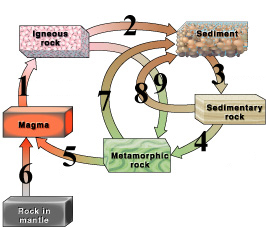:-) innovation: food geology
70% of the world's fresh water in held in glaciers
Running water is mostly responsible for shaping Earth's land surface.
Glaciers are far more effective agents of erosion, transportation, and deposition.
Ice Age glaciation
nondescript valley
Paleozoic glacial age
A glacier is a large, long-lasting mass of ice, formed on land, that moves under it's own weight. It develops as snow is compacted and crystallized. Glaciers can develop any place where, over period of years, more snow accumulates that what melts away or what is lost.
Are there types of glaciers? If so, what are they?
These are the types of glaciated terrain on Earth's surface.
1. Alpine glaciers is found in mountainous regions.
2. Continental glaciers exists where a large part of a continent is covered by glacial ice.
Types of Glaciers
1. Valley glacier - valley, high to low elevation, prevalent in areas of alpine glaciation
2. a. Ice sheet - covers a large area of mass, continental glaciation, Greenland and Antarctica
b. Ice cap - smaller ice sheet
Both flows downward and outward from a central high point. Like a negative lava.
1/10th of land surface are covered by glaciers
1/3rd peak during glacial ages
Where are the glaciers?
85% Antarctic melt: 65 m (213 ft) rise
10% Greenland
5% others (freshwater)
How do glaciers form?
Just a process of compaction and crystallization.
It starts with a single snowflake. Snowflakes pile up they form a granular flow, glue multiple granular flow you get a firn, it's basically a snowball, then pile up a bunch of snowballs, you get a glacier ice.
Ablation is ice flow just as chocolate melts.
Sublimation is a process in which ice evaporates directly to the atmosphere.
Calve is ice break off. A divorce of ice.
Glacial Budgets
+ positive expand = advancing glaciers
- negative shrinks = receding glaciers
_ balanced budget
Zone of accumulation - up G
Zone of ablation - down G
-ice is ablated, evaporated, melted, called
Equilibrium line - snow line, firn line, boundary line
Terminus - lower edge of a glacier
* valley glacier
+ T down
- T up
However, an advancing glacier doesn't mean it's getting colder, it just means that it's getting wetter, more precipitation is falling during the winter months, or the summers are cloudy, that means reducing the warmth of sunlight passing through.
5°C lowering will mean new ice age
How do glaciers move?
Less than few mm to 15 m in a day
Even glacier gradient has the thickest near equilibrium line.
Fastest moving ice near equilibrium line.
Slow after E.L.
Faster in temperate climate than colder ones.
Surface moves faster than base.
Basal sliding is the sliding of the glacier as a single body over the underlying rock. Just like melting ice cream placed on a surface.
Plastic flow - movement of ice grains which they slide past one another though both grains move at the same time as one body.
Rigid zone - rigid movement, ice grains move as one though still aligned with the adjacent ice grains.
Crevasses - open fissure, develop also in curve path
Outlet glaciers - where mountain ranges are higher than the ice sheet, the ice sheet flows between mountains as valley glaciers
Ice streams - faster movement than in adjoining ice, which is frozen to it's bed, like a corpse
Glacial Erosion
Plucking - water will percolate to the rock cleavage then it will freeze again, and as the glacier move, it breaks and erode the rock underneath, more like a nose pack for rocks
Faceted - a surface formed through ablation
Striated - scratched
Rock flour - rock to rock grinding
Glacial Valleys
U-shaped valley, glacial erosion
V-shaped valley, stream erosion
Hanging valleys - higher than main valley, a toilet bowl sliced by a samurai
Truncated spurs - ridges with triangular facets produced by glacial erosion at lower ends
Cirque - steep-sided, half-bowl-shaped recess carved into a mountain at the head of a valley carved by a glacier, a half-eaten cupcake
Horn - sharp peak that remains
Aretes - sharp ridges, separate adjacent glacially carved valleys
Glacial Deposition
Till - the unsorted and unlayered rock debris carried or deposited by a glacier
Erratic - ice-transported boulder that has not been derived from underlying bedrock, wandering rock
Moraines - the till that occurs as a body of unsorted and unlayered debris either on the glacier itself, or what has been left by the glacier, think of a giant glacier worm devouring rock debris and excrete it as it moves, the poop is the moraine
Medial moraine - adjacent lateral moraine join and carried as a long ridge of till
End moraine - a ridge of till that piles up along the front edge of the ice, crescent-shaped or horshoe-shaped
A. Terminal moraine - end moraine marking the farthest advance of a glacier
B. Recessional moraine - end moraine built while terminus of a receding glacier remains temporarily stationary
Ground moraine - thin blanket of till
Drumlins - bodies of till shaped into streamlined hills, shaped like an inverted spoon
Outwash - material deposited by the debris-laden meltwater
Esker - an outwash feature of unusual shape associated with former ice sheets and some very large valley glaciers; a long, sinuous ridge of water-deposited sediment, pronounced: esssker, serpent kame
Kettle - it is formed when the ice block finally melts
Kame - low mound or irregular ridge formed or outwash deposits of stagnating glacier
Kame and kettle topography
Varve - two layers of sediment representing one year's deposition in a lake
Pluvial lakes - formed in a period of abundant rainfall
Fiord - a coastal inlet that is drowned glacially carved valley
Tillite - lithified till


